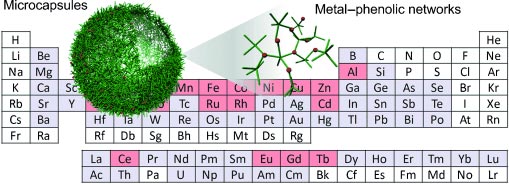Versatile Capsules

Microcapsules with a broad spectrum of applications in biomedicine, catalysis, and technology can be produced by using plant-derived, phenolic tannic acid and a variety of metals. The capsules are formed by a simple self-assembly process, and their properties can be controlled through the choice of metal, as demonstrated by a team of Australian and German researchers in the journal Angewandte Chemie.
Metals and organic molecules can combine to form coordination compounds whose structure and properties depend on the components. Examples from nature include the oxygen-binding heme groups in our red blood cells with their central iron atom or the magnesium complex at the heart of photosynthesis. Scientists have also explored the use of these types of compounds to build things, such as networked scaffold structures.
A team from the University of Melbourne, the Baker IDI Heart and Diabetes Institute (Melbourne, Australia), and the University Medical Center Freiburg (Germany), is particularly interested in structures in the form of hollow capsules. Led by Frank Caruso, these researchers haven now been able to demonstrate that a single organic ligand, tannic acid, can coordinate to 18 different metals to form capsules made of metal–phenolic networks (MPNs). The metals are aluminum, vanadium, chromium, manganese, iron, cobalt, nickel, copper, zinc, zirconium, molybdenum, ruthenium, rhodium, cadmium, cerium, europium, gadolinium, and terbium.
The production method is simple: just mix tannic acid with a solution of the desired metal ion in the presence of a suitable substrate—in this case microparticles. Removal of the substrate leaves behind hollow microcapsules.
The properties of the capsules depend on the type and number of metal ions. For example, capsules with aluminum have a property profile suitable for drug transport: while they are relatively stable at pH values typical of blood, they come apart at the lower pH values found in some cell compartments. They could thus be used to transport a drug though the blood and release it after entering a cell.
Capsules with europium and terbium ions can be used for multicolored fluorescence labeling of biological samples, as well as for technological applications like flexible color displays. Capsules with manganese are highly promising contrast agents for magnetic resonance imaging (MRI). Capsules with radioactive copper isotopes are good tracers for positron emission tomography (PET). Properties like size, shape, and surface chemistry could be tailored to control the distribution of the capsules in the body. Capsules with radioactive copper and europium could allow for tissue samples to undergo PET followed immediately by fluorescence microscopy.
Catalysis is another possible application. The researchers were able to show that capsules with rhodium catalyze the hydrogenation of quinoline at least as well as conventional rhodium catalysts.
About the Author
Frank Caruso is a professor and Australian Research Council (ARC) Laureate Fellow at The University of Melbourne, Australia. He is also a Director of the ARC Centre of Excellence in Convergent Bio-NanoScience and Technology and is a Fellow of the Australian Academy of Science. His research interests focus on developing advanced nano- and biomaterials.
Author: Frank Caruso, University of Melbourne (Australia), http://www.chemeng.unimelb.edu.au/people/staff.php?person_ID=16579
Title: Engineering Multifunctional Capsules through the Assembly of Metal–Phenolic Networks
Angewandte Chemie International Edition, Permalink to the article: http://dx.doi.org/10.1002/anie.201311136
Media Contact
More Information:
http://pressroom.angewandte.orgAll latest news from the category: Life Sciences and Chemistry
Articles and reports from the Life Sciences and chemistry area deal with applied and basic research into modern biology, chemistry and human medicine.
Valuable information can be found on a range of life sciences fields including bacteriology, biochemistry, bionics, bioinformatics, biophysics, biotechnology, genetics, geobotany, human biology, marine biology, microbiology, molecular biology, cellular biology, zoology, bioinorganic chemistry, microchemistry and environmental chemistry.
Newest articles

A universal framework for spatial biology
SpatialData is a freely accessible tool to unify and integrate data from different omics technologies accounting for spatial information, which can provide holistic insights into health and disease. Biological processes…

How complex biological processes arise
A $20 million grant from the U.S. National Science Foundation (NSF) will support the establishment and operation of the National Synthesis Center for Emergence in the Molecular and Cellular Sciences (NCEMS) at…

Airborne single-photon lidar system achieves high-resolution 3D imaging
Compact, low-power system opens doors for photon-efficient drone and satellite-based environmental monitoring and mapping. Researchers have developed a compact and lightweight single-photon airborne lidar system that can acquire high-resolution 3D…





















